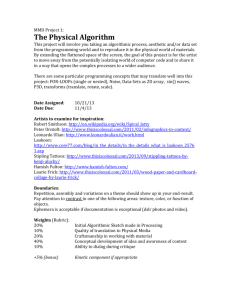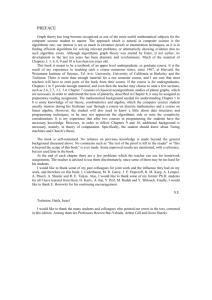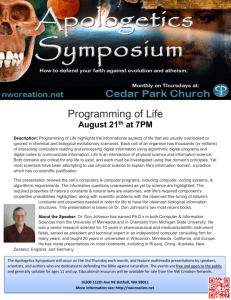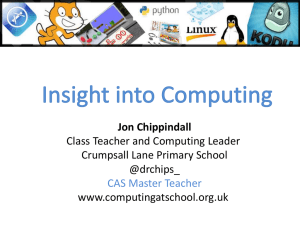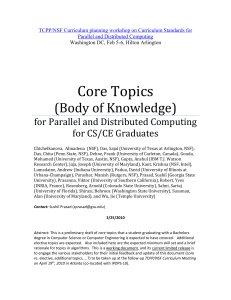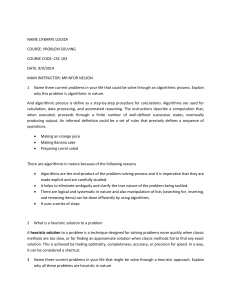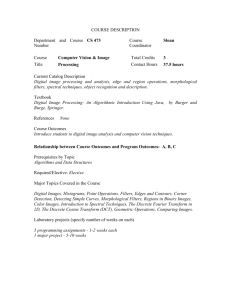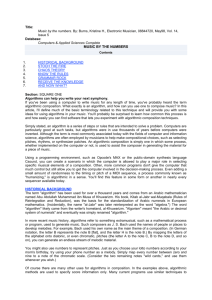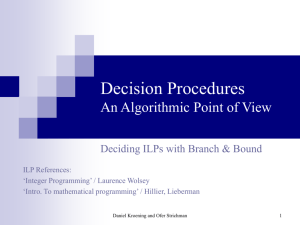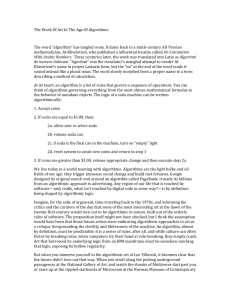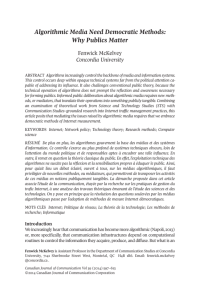Word document - Cornell University
advertisement
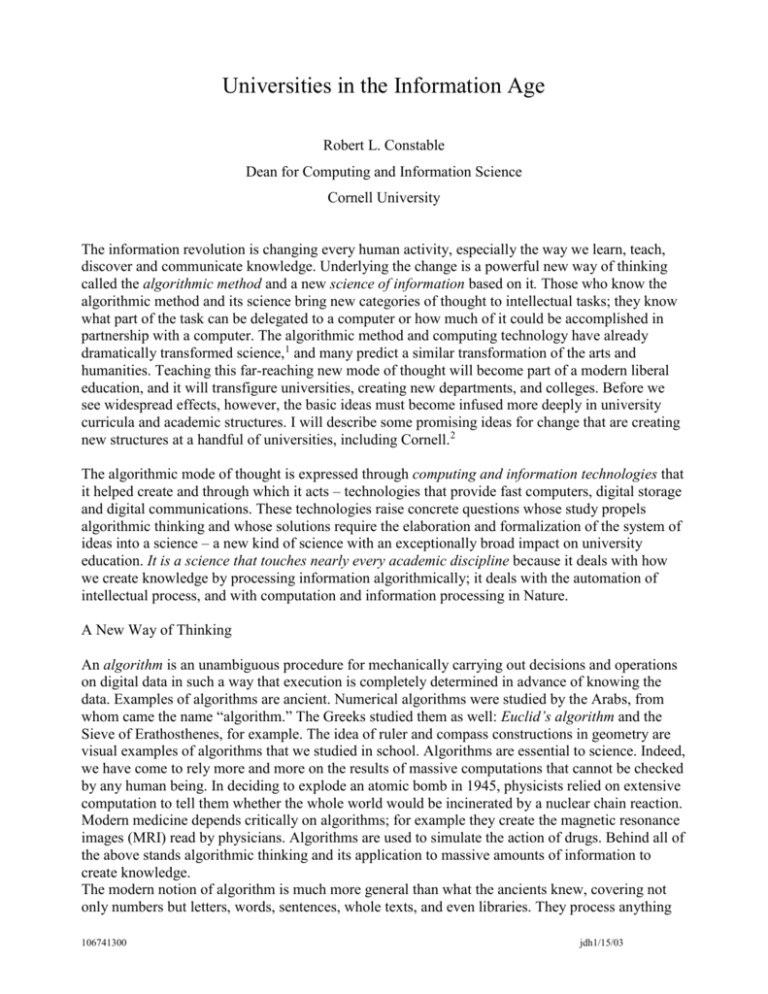
Universities in the Information Age Robert L. Constable Dean for Computing and Information Science Cornell University The information revolution is changing every human activity, especially the way we learn, teach, discover and communicate knowledge. Underlying the change is a powerful new way of thinking called the algorithmic method and a new science of information based on it. Those who know the algorithmic method and its science bring new categories of thought to intellectual tasks; they know what part of the task can be delegated to a computer or how much of it could be accomplished in partnership with a computer. The algorithmic method and computing technology have already dramatically transformed science,1 and many predict a similar transformation of the arts and humanities. Teaching this far-reaching new mode of thought will become part of a modern liberal education, and it will transfigure universities, creating new departments, and colleges. Before we see widespread effects, however, the basic ideas must become infused more deeply in university curricula and academic structures. I will describe some promising ideas for change that are creating new structures at a handful of universities, including Cornell.2 The algorithmic mode of thought is expressed through computing and information technologies that it helped create and through which it acts – technologies that provide fast computers, digital storage and digital communications. These technologies raise concrete questions whose study propels algorithmic thinking and whose solutions require the elaboration and formalization of the system of ideas into a science – a new kind of science with an exceptionally broad impact on university education. It is a science that touches nearly every academic discipline because it deals with how we create knowledge by processing information algorithmically; it deals with the automation of intellectual process, and with computation and information processing in Nature. A New Way of Thinking An algorithm is an unambiguous procedure for mechanically carrying out decisions and operations on digital data in such a way that execution is completely determined in advance of knowing the data. Examples of algorithms are ancient. Numerical algorithms were studied by the Arabs, from whom came the name “algorithm.” The Greeks studied them as well: Euclid’s algorithm and the Sieve of Erathosthenes, for example. The idea of ruler and compass constructions in geometry are visual examples of algorithms that we studied in school. Algorithms are essential to science. Indeed, we have come to rely more and more on the results of massive computations that cannot be checked by any human being. In deciding to explode an atomic bomb in 1945, physicists relied on extensive computation to tell them whether the whole world would be incinerated by a nuclear chain reaction. Modern medicine depends critically on algorithms; for example they create the magnetic resonance images (MRI) read by physicians. Algorithms are used to simulate the action of drugs. Behind all of the above stands algorithmic thinking and its application to massive amounts of information to create knowledge. The modern notion of algorithm is much more general than what the ancients knew, covering not only numbers but letters, words, sentences, whole texts, and even libraries. They process anything 106741300 jdh1/15/03 2 that can be represented digitally. They work across many levels of abstraction, from bits to threedimensional models of proteins or models of space and models of the mind.3 They structure a new understanding physical laws; the eminent physicist and science writer Paul Davies has said, “Quantum computation is the nexus at which ‘software’ concepts such as information, randomness and order, tangle with ‘hardware’ concepts such as matter and force.”4 Nature appears to use algorithms to control the chemical processes of life, and the neurological processes of brains, and the information processing of minds. Understanding computation in Nature is yet another illustration that the fundamental ideas apply widely and provide a new way of understanding the world. Transforming Scholarship Algorithmic thinking has transformed mathematics and the sciences. It will also transform scholarship and the arts as computing and information scientists partner with scholars to create new tools for thought. Experimental tools show the way, as with Terminal Time, a system for automatically creating historical narrative from a database of facts covering the last thousand years (1568 facts are used) and assembled according to nine major ideologues.5 There will be tools to help scholars examine digitized primary sources more rapidly and automatically provide views of the information that guides historical analysis. Materials will be automatically summarized and classified. Primary historical data will be available so that in certain history courses students will have direct access to the sources from which the professional historian draws conclusions. Access to sources and process will render history a more objective enterprise in which the causal narrative will be tested by informed lay readers. There are history courses taught this way now at the University of Virginia; there professors and students are changing the way history is learned.6 The data are here, as literature Nobel Laureate Jose Saramago expresses it, “like a pulsating galaxy ... the words ... form another cosmic dust hovering in anticipation of that glance [computation] which will impose some meaning.”7 When educators and social scientists want to study the impact of new ways of teaching history, they might have access to the entire record of email discourse between professors and students for many such courses. This interaction is being explored by social scientists and computer scientists at Cornell.8 We will keep a detailed record of how thousands of people learn. We will automatically examine this record to learn from it. These are examples of the algorithmic method applied to social science research. Challenge to University Education Liberal education introduces students to the major modes of thought developed over the centuries. The algorithmic mode of thought is taking its distinctive place among the others. Comparing the algorithmic mode of thought to the established ones helps us better appreciate its fundamental novelty. Consider the historical mode, one of the most venerable. We can still study the ancients such as Thucydides to learn it. Consider the mathematical modes of thought, such as the deductive method invented by the Greeks; we can still learn it from Euclid. In contrast, the algorithmic method did not exist before the 1940’s. It was not taught until the 50’s. We cannot learn it from Euclid nor from Newton, nor from Einstein. We learn it from Turing and Church and those who came immediately after them.9 Turing defined the general concept of an 106741300 jdh1/15/03 3 algorithm, he created the idea of a universal computing machine, and he was involved in the design of the first digital computer, which is a physical realization of a universal computer. So the general algorithmic method is a new mode of thought distinct from all others. It is taught in computer science. It will not remain confined to science and engineering. The idea of a liberal education is beginning to include the notion that all educated citizens must be familiar with the basic concepts and vocabulary of the information sciences as well as with those of the physical and life sciences. For example, students must know how to assemble an authoritative argument that draws on information from the Web and uses automated tools to find that information. To do that properly, students need to understand the limitations of these tools; that in turn requires knowing about the algorithms they use and the intellectual processes they are capable of automating adequately. There are new responsibilities for citizens of the Information Age. Will they be able to see the ethical assumptions embedded in software? Can they enforce the ethical behavior they want from their own computer when it participates in peer-to-peer transactions? Will they be able to distinguish aspects of software system design that are based on values versus those imposed by technical imperatives? Can they detect when code is creating or destroying culture? There must be a basis for continuing life-long education in this field, because not all citizens will work close to the source of the new ideas. The foundations for meaningful life-long education are laid in our concept of a liberal education. What is the impact of this revolution on universities? It created computer science departments in every major university. Traditionally computer science majors have come with backgrounds and interests in mathematics, physical sciences or engineering, but major successes of the algorithmic method appear in psychology and cognitive science, in economics and in the biological sciences, and more will follow in the humanities. Students with an interest in the social sciences, biological sciences, the humanities and the arts are increasingly eager to learn aspects of computing and information science without also studying the physical sciences in equivalent depth. Many universities are developing promising ways to offer degrees based on these interests and to offer students in the humanities and the arts a rich connection to computing. Cornell is one, and that work is being reported on the Web, as Cornell creates Information Science and Digital Arts & Graphics.2 Conclusion The Industrial Revolution helped deepen the physical sciences and refined the scientific method; it also created new departments and then finally colleges of engineering. The Information Revolution will help deepen computing and information science; it will improve the algorithmic method; and it will create new colleges of computing and information science. We see signs of this already. But is there more beyond even these major changes? The new programs, departments, schools and colleges are direct reflections of the intellectual impact of the Information Revolution. The basic underlying fact driving all of these major changes is that algorithmic thinking clarifies any cognitive task, sharpens any problem and helps quicken any intellectual activity. As we support this mode of thought with better tools and further develop its science, its impact on learning in all disciplines will increase – spreading in ever wider waves from its origins in mathematical and scientific thinking. 106741300 jdh1/15/03 4 Acknowledgements: Glenn Altschuler, Larry Finkelstein, Juris Hartmanis, Amy E. Keating, Klara Kedem. Notes 1. George Johnson, “All Science is Computer Science” (in New York Times, March 25, 2001). 2. See Cornell in the Information Age at www.cs.cornell.edu, and also Robert L. Constable, The Nature of the Information Sciences, www.cs.cornell.edu/cis-dean/Nature.htm. New academic programs are described at www.fci.cornell.edu. 3. Steven Pinker, How the Mind Works (W.W. Norton & Co, 1997). 4. Davies quote comes from his foreword to Gerard J. Milburn’s book, The Feynman Processor (Perseus, 1998). Similar ideas appear in Roland Omnes, Quantum Philosophy (Princeton University Press, 1999), and in Tom Siegfried, The Bit and the Pendulum (John Wiley & Sons, 2000). 5. Michael Mateas, Paul Vanouse, and Steffi Domike, "Generation of Ideologically-Biased Historical Documentaries" (in Proceedings of AAAI 2000, pages 36-42. Austin, TX, 2000.). 6. Edward L. Ayers and Anne S. Rubin, The Valley of the Shadow: Two Communities in the American Civil War (W.W. Norton & Co, 2000). The Valley Project is located on the web at: www.iath.virginia.edu/vshadow2/contents.html. 7. José Saramago, The History of the Siege of Lisbon (Harcourt Brace & Co., 1996). 8. Scott Carlson, “Researchers Conclude That Wireless Technology Is a Double-Edged Sword” (in The Chronicle of Higher Education, March 21, 2001, Information Technology section). 9. Andrew Hodges, Alan Turing: The Enigma (Simon & Schuster, 1983). 106741300 jdh1/15/03
